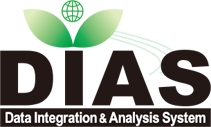


  |  |
| Name | Typhoon DDS for changing climate by a regional a–o coupled model |
| DOI | doi:10.20783/DIAS.666 |
| Metadata Identifier | 4TYs_PGW_CReSS_NHOES20240422101118-DIAS20221121113753-en |
| Name | Sachie Kanada |
|---|---|
| skanada@nagoya-u.jp |
| Name | DIAS Office |
|---|---|
| Organization | Japan Agency for Marine-Earth Science and Technology |
| Address | 3173-25, Showa-Cho, Kanazawa-ku, Yokohama-shi, Kanagawa, 236-0001, Japan |
| dias-office@diasjp.net |
| Name | Sachie Kanada |
|---|
| Name | Sachie Kanada |
|---|
creation : 2023-12-27
The pseudo global warming (PGW) experiments on four historical intense typhoons under four different warming conditions were conducted using a regional high-resolution three-dimensional atmosphere–ocean coupled model, CReSS-NHOES (Aiki et al., 2015). Four historical intense typhoons that traveled northward and affected Japan, Typhoons Trami (2018), Faxai (2019), Hagibis (2019), and Haishen (2020), were selected. The PGW increments were made from the Database for Policy Decision-Making for Future Climate Change (d4PDF), which includes 100 ensembles of pre-industrial, historical, and 2 K and 4 K warmer climate experiments with a 60-km-mesh atmospheric global circulation model (Mizuta et al. 2017). See Figure S1 and Tables S1 and S2 of Kanada and Aiki (2024) for more information about the experiments and the initial and boundary conditions used. This dataset includes hourly outputs from the atmospheric and oceanic parts.
climatologyMeteorologyAtmosphere
| Begin Date | 2018-09-26 |
| End Date | 2020-09-06 |
| Temporal Characteristics | Hourly |
| North bound latitude | 43 |
| West bound longitude | 124 |
| Eastbound longitude | 154 |
| South bound latitude | 14 |
| Dimension Name | Dimension Size (slice number of the dimension) | Resolution Unit |
|---|---|---|
| row | 0.01/0.02 (deg) | |
| column | 0.01/0.02 (deg) | |
| vertical | 10-2000 (m) |
| Keyword Type | Keyword | Keyword thesaurus Name |
|---|---|---|
| theme | Atmosphere > Atmospheric Phenomena > Typhoons, Human Dimensions > Natural Hazards > Tropical Cyclones > Typhoons | GCMD_science |
| theme | Climate | GEOSS |
| Keyword Type | Keyword | Keyword thesaurus Name |
|---|---|---|
| theme | DIAS > Data Integration and Analysis System | No_Dictionary |
file download : https://data.diasjp.net/dl/storages/filelist/dataset:666
The datasets contain the following files and variables. out_cress (CReSS outputs): 1) Two dimensional surface data (EXID_CLIMID.sfc_ YYYY_MO_DD_HHMMUTC.z56.bin)[hourly; sea level pressure, velocity in lon and lat-directions at 10m, soil and sea surface temperature, rain fall rate, accumulated rain fall] 2) Three dimensional atmospheric data1 (EXID_CLIMID.dmp_ YYYY_MO_DD_HHMMUTC.z56.bin)[hourly; zonal, meridional and z components of velocities, pressure, potential temperature, water vapor mixing ratio] 3) Three dimensional atmospheric data2 (EXID_CLIMID.cld_ YYYY_MO_DD_HHMMUTC.z56.bin)[hourly; cloud, rain water, cloud ice, snow, graupel mixing ratio] 4) User namelist (".user.conf") out_nhoes (NHOES outputs): 5) Three dimensional oceanic data (nhoes_EXID_CLIMID.YYYY_MO_DD_HHMMUTC.z80.bin)[hourly; u, v, w, temperature, salinity, density] 1)-3)and 5) are 4byte binary (big endian) data files with corresponding Grads ctl files. The extension ".bin" is for the data file and ".ctl" is for the Grads ctl file. Trami (Directory: TRAMI2018, EXID: T1824_2606_1km), Faxai (FAXAI2019, T1915_0700_1km), Hagibis (HAGIBIS2019, T1919_1018_1km),Haishen (HAISHEN2020, T2010_0112_2km). Control (CLIMID: CNTL), pre-industrial (NAT), and 2 K (2K) and 4 K (4K) warmer climate experiments. EXID: Experiment ID, CLIMID: Climate ID, YYYY: Year MO: Month DD_HHMM: Day, hour, and minutes.
Data Polilcy:
1. Individual users should not redistribute the data to any third party.
2. The source of the database should be acknowledged in scientific and technical papers, publications, press releases and other communications in case of using the data.
Disclaimer:
The intellectual property rights of the dataset belong exclusively to Nagoya university. Nagoya university and anyone, including the creator (and all individuals and organizations involved in the creation of this dataset), are not responsible for any damage that may result from the use of this dataset.
If data provider does not have data policy, DIAS Terms of Service (https://diasjp.net/en/terms/) and DIAS Privacy Policy (https://diasjp.net/en/privacy/) apply.
If there is a conflict between DIAS Terms of Service and data provider's policy, the data provider's policy shall prevail.
 CC-BY-NC 4.0 :
Creative Commons Attribution-NonCommercial 4.0 International
CC-BY-NC 4.0 :
Creative Commons Attribution-NonCommercial 4.0 International
The computation was carried out on the supercomputer "Flow" at Information Technology Center, Nagoya University. This work was partially supported by Japan Society for the Promotion of Science KAKENHI Grants 20H05166 and 19H05696.
If you plan to use this dataset for a conference presentation, paper, journal article, or report etc., please include acknowledgments referred to following examples. If the data provider describes examples of acknowledgments, include them as well.
" In this study, [Name of Dataset] provided by [Name of Data Provider] was utilized. This dataset was also collected and provided under the Data Integration and Analysis System (DIAS), which was developed and operated by a project supported by the Ministry of Education, Culture, Sports, Science and Technology. "
PGW experiment:
Kanada, S., and H. Aiki, 2024: Buffering effect of atmosphere–ocean coupling on intensity changes of tropical cyclones under a changing climate. Geophysical Research Letters, 51, e2023GL105659. https://doi.org/10.1029/2023GL105659
CReSS-NHOES:
Aiki, H., M. Yoshioka, M. Kato, A. Morimoto, T. Shinoda, and K. Tsuboki, 2015: A coupled atmosphere-ocean-surface-wave modeling system for understanding air-sea interactions under tropical cyclone conditions, Bull. Coastal Oceanogr., 52, 139–148.
d4PDF:
Mizuta, R., and co-authors, 2017: Over 5000 Years of Ensemble Future Climate Simulations by 60 km Global and 20 km Regional Atmospheric Models. Bull. Amer. Meteor. Soc., 1383–1398, doi:10.1175/BAMS-D-16-0099.1.